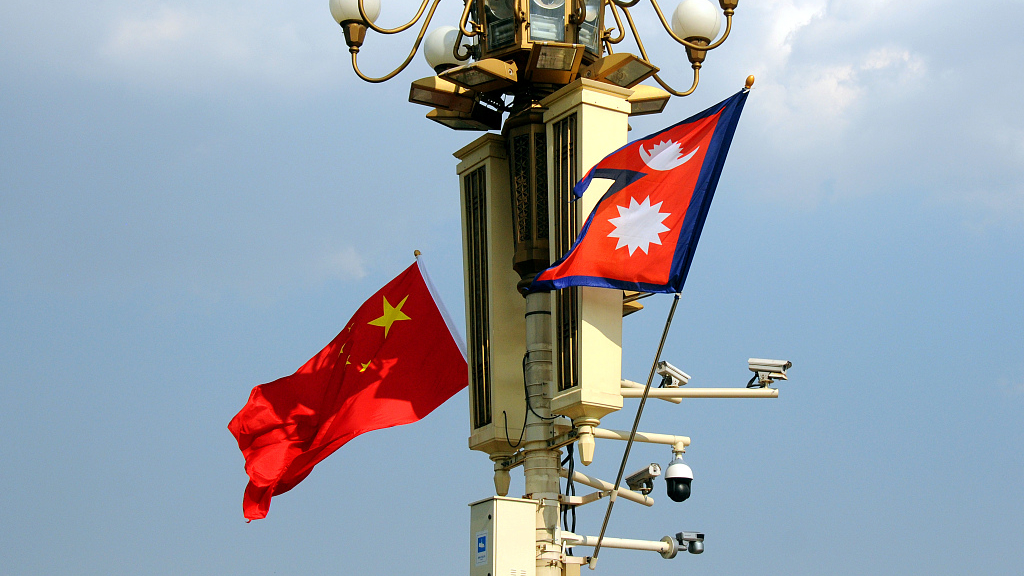

Editor's note: Mahendra Subedi is a Nepali journalist currently in Beijing. The article reflects the author's opinion, and not necessarily the views of CGTN.
Connected by the world's tallest mountains, Nepal and China enjoy age-old bilateral relations though formal ties between the two countries were established on August 1, 1955. The two countries share the fruits of the Sino-Nepal friendship for mutual benefits and greater good. China and Nepal are good neighbors, good friends and good partners. Being friends of weal and woe, China has been supporting Nepal during times of difficulty and participating in economic and social development, while Nepal is also fully committed to China's core interests.
Nepal remains firm in its one-China policy, and will not tolerate any activities against China on her soil. Since the bilateral relations have been continuously fostered over the past decades, the two countries enjoy a trouble-free relationship that exemplifies how neighboring countries with differences in population size, geography, economy and political system can enjoy a profound friendship.
In the book "You and US: Stories of China and Nepal," Chinese Foreign Minister Wang Yi writes: "On the basis of the Five Principles of Peaceful Coexistence, the two sides have established a lasting comprehensive cooperative partnership, enhanced political trust, increasingly rich pragmatic cooperation and deepening friendship. The two countries have become good cooperative partners which have always given each other firm support in regard to issues concerning core interests." This statement clearly hints at the dimensions and gamut of China-Nepal relations.
Buddhism is a key bridge linking Nepal and China since ancient times. Centuries ago, Nepali monk Buddhabhadra and Chinese Buddhist scholars Fa Xian and Xuan Zang traveled together across the high mountains to spread Buddha's message of peace and compassion. Their profound contributions to the spread of Buddha's teachings continue to bind the two countries together.
Similarly, famous Nepali artist Araniko during the Yuan Dynasty (1271-1368) in China contributed significantly to foster the ties through his architectural talents. Such links between the two countries at the people-to-people level continue to grow till date. What makes us even happier is that the people-to-people and cultural exchanges between the two countries have become increasingly dynamic. The long history of exchanges and bilateral relations has further enhanced various fields based on equality, mutual respect and benefits, as dozens of exchange programs are taking place every year on youth, education, arts, culture, agriculture and development, among others.
With Nepal's participation in the Belt and Road Initiative (BRI), the relations have further cemented while the exchanges of visits have become more frequent than before. In regard to the bilateral relations, China remains a major development partner, a key source of foreign direct investment and a trustworthy friend. Unlike others', China's development support to Nepal is channelized through the government system and is not attached to any string of conditionality.

The opening ceremony of International Mountain Tourism Day held in Kathmandu, Nepal, May 29, 2019. /VCG Photo
During the time of formal ties, Nepal and China have witnessed almost the same period of transition. Nepal was just welcoming a new dawn of democracy by uprooting 104 years of Rana oligarchy while China was entering into a completely new stage by establishing the People's Republic in 1949. So, it was a mutually beneficial move for both countries to expand their relations and share common experiences for development. However, China made miraculous changes in its socio-economic development by bringing more than 700 million people out of poverty line and becoming the world's second largest economy.
At present, China is Nepal's most important development partner in the areas of infrastructure, power development, optic cable communication, agriculture, technological advancement, education, culture, tourism and aviation, health service and cultural heritage renovation. There are dozens of projects either completed or under construction with Chinese assistance. Recently, Chinese companies, both private and state owned, are investing in power production, processing industries, mining and tourism-related industries, creating more jobs and contributing to Nepal's development path.
Likewise, with China being the world's top source country for tourists, Nepal wants to benefit from the Chinese market by bringing in more Chinese tourists. In the recent years, there has been an impressive growth of Chinese tourists in Nepal. In 2018, the number of Chinese tourists remained at 154,000, but the number is expected to surge further this year. As Nepal is marking Visit Nepal Year 2020, China is obviously a key source country for meeting Nepal's target to receive 2 million foreigners.
The future of Nepal-China relations would also remain rosy thanks to mutual respect for each other's core interests and China's unwavering support for Nepal's development. Similarly, the BRI would be a major pillar for boosting our relations through connectivity of policy, infrastructure, trade, finance and people-to-people relations. As South Asia is an important partner for promotion of the BRI, Nepal can become the focal point for South Asia and China and translate the peoples' dreams for socio-economic transformation through high-quality development by building our trust.
(If you want to contribute and have specific expertise, please contact us at opinions@cgtn.com.)

Copyright © 2018 CGTN. Beijing ICP prepared NO.16065310-3
Copyright © 2018 CGTN. Beijing ICP prepared NO.16065310-3